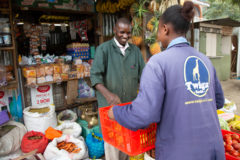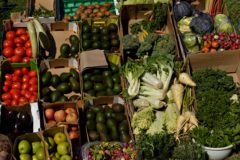Food is expensive in many African countries and not enough for everyone. It has caused political revolutions in Egypt, Sudan, and Tunisia. And it was the inspiration for the 1985 hit, ‘We Are the World,’ courtesy of Lionel Richie and Michael Jackson. Yet the problem is far from being solved. Technology companies are stepping into the ring of entities duelling with this problem, and they have a chance to show that aggregating smallholder farmers with technology and farming support can make a dent.
South Africans spend a third of their income on food. In 2021 Egyptian families reportedly spent up to 45% of their monthly expenditure on food. In Kenya the figure rises to 46.7%, Cameroonian families spend 45.6%, and in Algeria, food gobbles 42.5% of monthly expenditure. In Nigeria, Africa’s most populated country, 56% of every naira earned is spent on food.
It is an unlikely problem given that Africans are more likely to work on a farm than any other job. In 2020, almost 44% of Africans were employed in the agriculture sector, according to Statista. Other sources put the figure much higher. Despite the agricultural sector providing work for more people than any other sector, 37 African countries (out of 54) face “hunger levels that are ‘Stressed’ or higher,” per the 2022 Global Hunger Index, an annual report from Concern Worldwide and Welthungerhilfe.
[ad]
For many decades, the hunger problem negatively defined Africa in Western media. A lot of that negative coverage has been reduced on the back of local and global criticism over the portrayal of Africa as a hungry continent. Fewer Africans are hungry relatively speaking and in absolute terms. However, while the number of people starving has reduced, the number of people who are one shock away from hunger has increased. In the last months of 2022, more than two-thirds (70%) of people most affected by the global food crises lived in just three East African countries—Ethiopia, Kenya, and Somalia.
Persistent insecurity in Africa’s backyards does more to undermine local and international aid efforts to improve agriculture and deliver help to affected populations, together with drier-than-normal weather the violence forces farmers to allow fertile fields to lie fallow or give up harvests. Russia’s invasion of Ukraine is a pain African countries could do without. But the bigger effect of the unfortunate war has been a cut in aid from Europe that supported hunger alleviation programs.
Still, local conflict is a more pressing challenge to building up Africa’s fragile agricultural ecosystems. Usually, the people who suffer the most are smallholder farmers in places affected by both a changing climate and violence. They usually depend on the food they produce to feed their families and sell the excess to earn some money. When they cannot go to their farms, everyone suffers.
From a big-picture perspective, things seem to be getting better—marginally and slowly. Farming practices have improved ever so slightly due to land reforms in some African countries. And more modern farming approaches are taking root. Showing that some of the problems facing efforts to provide sufficient food for Africans are more solvable than stopping gunfights. Importantly Africa’s growing class of tech entrepreneurs who typically focus on digital payment technologies are finding the opportunity to solve these problems attractive.
Take ThriveAgric for example, a Nigerian startup that combines financing with market access support for smallholder farmers. In the last 3 years, Thrive Agric has built a network of 500,000 farmers that it supports with financing for farm inputs. The company has also entered partnerships with commodity boards to help it find markets for the farmers they support.
Earlier this year, Thrive Agric announced that it had hit a milestone of $100 million in credit lent to farmers in its network. Thrive Agric is not paid back in cash. It loans against expected crop yield, works with the farmers to improve yield and manage farming operations and sells the harvest to a network of off-takers. Profits are shared with farmers, Oshone Anavhe, Thrive Agric’s VP of operations explained. This creates an interesting model that effectively aggregates smallholder farmers and lends Thrive Agric the scale of a commercial player—albeit with more people employed.
It was not always a smooth ride for Thrive Agric. It originally began life as a crowdfunding platform that funded farmers and split 80% of profits between farmers and subscribers and kept 20% for itself. But Covid-19 pandemic restrictions changed that and almost sank the startup before it managed a turnaround and opted to pursue a model that relied on institutional funding instead of flighty short-term loans from multiple subscribers.
The firm has since raised money from Nigeria’s central and commercial banks, Ventures Platform, the World Food Program, and USAID.
Startups like Thrive Agric may be key to resolving one of the big problems facing agriculture across the continent. Which is that most of Africa’s farms are too small to produce much more than the farmer’s family will eat for the farming season. Aggregating these smallholder farms with technology and input support is one way to derive some of the efficiencies of large farms without actually owning a large farm.
South Africa, the continent’s leading agricultural producer, is a model of agricultural efficiency for the rest of the continent. It has both the largest agricultural land on the continent—96 million hectares—and the largest concentration of commercial farmers at 32,000. Between 5,000 to 7,000 of these farmers produce four-fifths of the country’s agricultural produce, according to the US International Trade Administration. Agricultural production in South Africa is complemented by a strong agro–processing industry that represents 18% of the manufacturing output of South Africa yearly. Processing raw produce from South African farms is second only to auto-manufacturing in terms of gross value added.
The country’s agricultural sector more than doubled in value and volume since 1994. It is one of the bright spots in South Africa’s economy despite the broader economic woes and even through Covid–19. “At the heart of its progress has been the rising productivity and growing exports. The productivity growth is on the back of technological advancement — biology and mechanical,” an agriculture sector expert, Wandile Sihlobo, told TechCabal. Sihlobo who is a member of the Economic Advisory Council of President Cyril Ramaphosa also doubles as chief economist of the Agricultural Business Chamber of South Africa.
It is not easy to replicate South Africa’s agricultural success without significant changes to local and national land ownership rules in Africa. And the capital required to build a processing industry is not insignificant.
But a key to starting might lie in Thrive Agric’s approach of aggregating smaller farms. In food processing, firms like Releaf are doing the same thing starting with sustainable oil palm in Nigeria. In Kenya and Rwanda, Victory Farms and Kivu Choice are integrating local small farms into their tilapia fish farming operations. And Synnefa in Kenya is providing smart greenhouses for small-scale farmers. Everywhere you look, it seems like there’s an agritech betting on aggregation.
Africa’s food problems will not be solved by food aid in the long term and massive food import bills are weighing heavily on forex reserves. Startup founders that venture into agriculture are taking on a big problem with often hidden nuances that outsiders do not see. Moreover, they still have to deal with infrastructure challenges, security problems, fragmentation, and unfavourable government policies.
The challenges are tough, but the rewards are significant—for the startups and local economies. If they can aggregate enough of the fragmented agricultural sector. If they can increase productivity using technology and ensure consistency in their aggregated portfolio. Then maybe they could create a new playbook for what is possible—a world where Africa’s smallholder farmers are empowered to produce, process and move food where it is needed the most. Something that government–run programs and food aid have failed to crack.




















